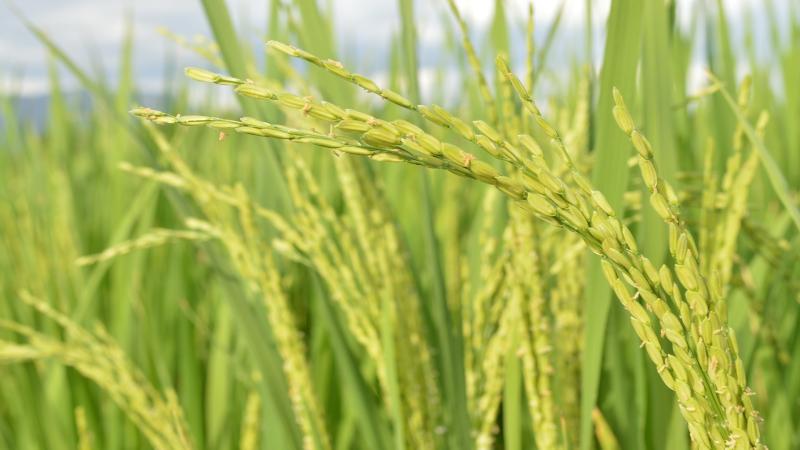
Among all the calamities caused by climate change, an increase in the salinity of the soil is one. It is projected that, by 2050, about half of today’s arable land across the world will be affected by salinity. This increase would also hit India’s rice bowl, the Indo-Gangetic plains, which is projected to lose about 45% of the crop yield. When salinity increases, plants respond by absorbing less water, which affects their growth. How then do we help agriculturally vital crops cope with high salinity? A new study by researchers from various institutes in Bengaluru may have found an answer in microbes.
In parts of coastal Kerala, there exists an interesting relationship—one between prawns, rice plants and microbes. A local variety of rice, known as the Pokkali rice, grows in brackish water by deriving nutrition from the excrements of the prawns. After the rice grains are harvested, baby prawns feed on the leftovers, devouring a tasty meal. Interestingly, a unique mix of bacteria and fungi that grow in the plant helps the Pokkali rice thrive despite the high salt content. These microbes are collectively called endophytes.
Endophytes are ‘good’ microbes that do not cause diseases, and instead, promote the plant’s growth. In a new study, researchers from University of Agricultural Sciences, ICAR-Indian Institute of Horticultural Research, Ashoka Trust for Research in Ecology and the Environment, in collaboration with scientists in the Institute of General Botany and Plant Physiology, Germany, have shown how one such endophyte, found in Pokkali rice, can turn salt-sensitive rice varieties into salt-tolerant ones. The study, published in the journal Scientific Reports, was funded by the Department of Biotechnology (DBT) and Indian Council of Agricultural Research (ICAR).
“We wanted to explore the larger role of endophytes in modulating plant responses to abiotic stresses, and if they can be extended to confer stress tolerance to stress-sensitive plants of agricultural importance,” says Dr Uma Shaanker, the corresponding author of the study. He is a professor at the Department of Crop Physiology and School of Ecology and Conservation, University of Agricultural Sciences, Bengaluru.
Harnessing the power of fungi
Studies in the past have shown that the use of endophytes in plants like tomato and chickpeas induces salt tolerance.
“Bacterial endophytes have been reported to confer salt tolerance to chickpea while the fungal endophyte, Aspergillus flavus, has been shown to mediate salinity tolerance in soybean,” says Dr Shaanker.
However, the current study is the first to show how endophytes from a salt-resistant variety of rice could be used to induce salt-tolerance in other types.
The researchers isolated several species of bacteria and fungi from two varieties of rice— the salt-tolerant Pokkali rice and the salt-sensitive IR-64. After analysing the growth of these plants in different salt conditions in the presence of microbes, they identified a type of fungi, called Fusarium, which thrived in salty conditions. The researchers then treated the seeds of IR-64 with this fungus and observed their growth in high and low salinity conditions.

Fusarium verticillioides - Image for representational purpose only.
Credits -Via Wikimedia Commons, Public Domain
The study found that the seeds treated with the fungus had better growth of roots and shoots even under salty conditions than those that were not. Interestingly, when the treated seeds were grown under low salt concentrations, the fungus did not influence their growth. The treated seeds also had high amounts of chlorophyll—the vital pigment for photosynthesis—in salty and normal conditions. The stability of the cell membrane, which usually reduces under high salt conditions, was found to be significantly higher in plants with the fungi.
The researchers also noticed several differences at the genetic level in IR-64 plants treated with the fungi.
“The endophyte treatment significantly altered gene expression”, says Dr Shaanker, adding that some genes were overexpressed and others were underexpressed. “The genes that were differentially expressed due to the treatment were linked to traits imparting salt tolerance,” he says.
Although the mechanism through which these differences are caused is not yet completely known, the researchers have observed changes in the perception of signals raised due to high salinity and the production of related proteins.
“The approach offers an exciting alternative to conventional plant breeding and genetic engineering-based solutions to ameliorate stress adaptations in plants,” explains Dr Shaanker, in a nutshell.
Endophytes - Our hope towards a food-secure future?
The findings of the study show how tiny microbes can help agriculturally important crops to adapt to stress conditions like high salt content. Although studies have shown that bacteria can help in salt tolerance and that genetic engineering can be used to design salt-tolerant varieties of plants, the approach used in this study is much simpler. “Treating seeds with endophytes can be easily done at the farm level,” says Dr Shaanker.
As a next step, the researchers are experimenting with plants like capsicum and maize to improve their salt tolerance with encouraging results. Salinity is a vital driver of plant growth, and the changes in salt levels due to the vagaries of the climate is now creating a need for developing crops that are climate-sensitive, and tolerate these changes. The approach used in the current study is a step in this direction.
“Our approach could accelerate crop improvement programmes and stress mitigating strategies relevant to Indian agriculture,” signs off Dr Shaanker.
This article has been run past the researchers, whose work is covered, to ensure accuracy.






